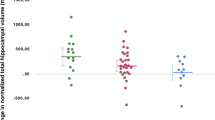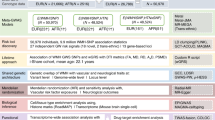Abstract
This longitudinal study examined the relationship between 2-year change in white matter hyperintense lesion (WML) volume and polymorphisms in genes coding for the angiotensin-II type 1 and type 2 receptors, AGTR1 A1166C and AGTR2 C3123A, respectively. 137 depressed and 94 non-depressed participants aged ⩾60 years were enrolled. Standard clinical evaluations were performed on all participants and blood samples obtained for genotyping. 1.5-T MRI (magnetic resonance imaging) data were obtained at baseline and approximately 2 years later. These scans were processed using a semi-automated segmentation process, which allowed for the calculation of WML volume at each time point. Statistical models were tested for the relationship between change in WML volume and genotype, while also controlling for age, sex, diagnostic strata, baseline WML volume and comorbid cerebrovascular risk factors. In men, AGTR1 1166A allele homozygotes exhibited significantly less change in WML volume than 1166C carriers. We also found that men reporting hypertension (HTN) with the AGTR2 3123C allele exhibit less change in WML volume than hypertensive men with the 3123A allele, or men without HTN. There were no significant relationships between these polymorphisms and change in WML volume in women. No significant gene–gene or gene–depression interactions were observed. Our results parallel earlier observed gender differences of the relationship between other renin–angiotensin system polymorphisms and HTN. Further work is needed to determine whether these observed relationships are secondary to polymorphisms affecting response to antihypertensive medication, and whether antihypertensive medications can slow WML progression and lower the risk of morbidity associated with WMLs.
This is a preview of subscription content, access via your institution
Access options
Subscribe to this journal
Receive 12 print issues and online access
$259.00 per year
only $21.58 per issue
Buy this article
- Purchase on Springer Link
- Instant access to full article PDF
Prices may be subject to local taxes which are calculated during checkout
Similar content being viewed by others
References
Longstreth WTJ, Manolio TA, Arnold A, Burke GL, Bryan N, Jungreis CA et al. Clinical correlates of white matter findings on cranial magnetic resonance imaging of 3301 elderly people: the cardiovascular health study. Stroke 1996; 27: 1274–1282.
Whitman GT . A prospective study of cerebral white matter abnormalities in older people with gait dysfunction. Neurology 2001; 57: 990–994.
Taylor WD, MacFall JR, Payne ME, McQuoid DR, Steffens DC, Provenzale JM et al. Greater MRI lesion volumes in elderly depressed subjects than in control subjects. Psychiatry Res 2005; 139: 1–7.
Liao D, Cooper L, Cai J, Bryan N, Burke G, Shahar E et al. The prevalence and severity of white matter lesions, their relationship with age, ethnicity, gender, and cardiovascular disease risk factors: the ARIC Study. Neuroepidemiology 1997; 16: 149–162.
Dichgans M . Genetics of ischaemic stroke. Lancet Neurol 2007; 6: 149–161.
Mogi M, Li J-M, Iwanami J, Min L-J, Tsukuda K, Iwai M et al. Angiotensin II type-2 receptor stimulation prevents neural damage by transcriptional activation of methyl methanesulfonate sensitive 2. Hypertension 2006; 48: 141–148.
Hindorff LA, Heckbert SR, Tracy R, Tang Z, Psaty BM, Edwards KL et al. Angiotensin II type 1 receptor polymorphisms in the cardiovascular health study: relation to blood pressure, ethnicity, and cardiovascular events. Am J Hypertens 2002; 15: 1050–1056.
Rubattu S, Di Angelantonio E, Stanzione R, Zanda B, Evangelista A, Pirisi A et al. Gene polymorphisms of the renin-angiotensin-aldosterone system and the risk of ischemic stroke: a role of the A1166C/AT1 gene variant. J Hypertens 2004; 22: 2129–2134.
Deinum J, van Gool JMG, Kofflard MJM, ten Cate FJ, Jan Danser AH . Angiotensin II type 2 receptors and cardiac hypertrophy in women with hypertrophic cardiomyopathy. Hypertension 2001; 38: 1278–1281.
Miyaki K, Hara A, Araki J, Zhang L, Song Y, Kimura T et al. C3123A polymorphism of the angiotensin II type 2 receptor gene and salt sensitivity in healthy Japanese men. J Hum Hypertens 2006; 20: 467–469.
Robins LN, Helzer JE, Croughan J, Ratcliff KS . National Institute of Mental Health Diagnostic Interview Schedule. Its history, characteristics, and validity. Arch Gen Psychiatry 1981; 38: 381–389.
Taylor WD, MacFall JR, Provenzale JM, Payne ME, McQuoid DR, Steffens DC et al. Serial MR imaging of hyperintense white matter lesion volumes in elderly subjects: correlation with vascular risk factors. Am J Roentgenol 2003; 181: 571–576.
Taylor WD, Steffens DC, MacFall JR, McQuoid DR, Payne ME, Provenzale JM et al. White matter hyperintensity progression and late-life depression outcomes. Arch Gen Psychiatry 2003; 60: 1090–1096.
Chen PS, McQuoid DR, Payne ME, Steffens DC . White matter and subcortical gray matter lesion volume changes and late-life depression outcome: a 4-year magnetic resonance imaging study. Int Psychogeriatr 2006; 18: 445–456.
Regier DA, Myers JK, Kramer M, Robins LN, Blazer DG, Hough RL et al. The NIMH Epidemiologic Catchment Area program: historical context, major objectives, and study population characteristics. Arch Gen Psychiatry 1984; 41: 934–941.
Montgomery SA, Asberg M . A new depression scale designed to be sensitive to change. Br J Psychiatry 1979; 134: 382–389.
Folstein MF, Folstein SE, McHugh PR . Mini-mental state a practical method for grading the cognitive state of patients for the clinician. J Psychiatr Res 1975; 12: 189–198.
Steffens DC, McQuoid DR, Krishnan KRR . The Duke Somatic Treatment Algorithm for Geriatric Depression (STAGED) approach. Psychopharmacol Bull 2002; 36: 58–68.
Payne ME, Fetzer DL, MacFall JR, Provenzale JM, Byrum CE, Krishnan KRR . Development of a semi-automated method for quantification of MRI gray and white matter lesions in geriatric subjects. Psychiatry Res 2002; 115: 63–77.
Kikinis R, Shenton ME, Gerig G, Martin J, Anderson M, Metcalf D et al. Routine quantitative analysis of brain and cerebrospinal fluid spaces with MR imaging. J Magn Reson Imaging 1992; 2: 619–629.
Henskens LHG, Kroon AA, van Boxtel MPJ, Hofman PAM, De Leeuw PW . Associations of the angiotensin II type 1 receptor A1166C and the NO synthase G894T gene polymorphisms with silent subcortical white matter lesions in essential hypertension. Stroke 2005; 36: 1869–1873.
Efron B, Tibshirani RJ . An Introduction to the Bootstrap. Chapman & Hall: New York, 1993.
Khoury S, Yarows SA, O'Brien TK, Sowers JR . Ambulatory blood pressure monitoring in a nonacademic setting. Effects of age and sex. Am J Hypertens 1992; 5: 616–623.
Bachmann J, Feldmer M, Ganten U, Stock G, Ganten D . Sexual dimorphism of blood pressure: possible role of the renin-angiotensin system. J Steroid Biochem Mol Biol 1991; 40: 511–515.
Reich H, Duncan JA, Weinstein J, Cattran DC, Scholey JW, Miller JA . Interactions between gender and the angiotensin type 1 receptor gene polymorphism. Kidney Int 2003; 63: 1443–1449.
Lynch AI, Arnett DK, Davis BR, Boerwinkle E, Ford CE, Eckfeldt JH et al. Sex-specific effects of AGT-6 and ACE I/D on pulse pressure after 6 months on antihypertensive treatment: The GenHAT study. Ann Hum Genet 2007; 71: 735–745.
Marciante KD, Bis JC, Rieder MJ, Reiner AP, Lumley T, Monks SA et al. Renin-angiotensin system haplotypes and risk of myocardial infarction and stroke in pharmacologically treated hypertensive patients. Am J Epidemiol 2007; 166: 19–27.
Takami S, Imai Y, Katsuya T, Ohkubo T, Tsuji I, Nagai K et al. Gene polymorphism of the renin-angiotensin system associates with risk for lacunar infarction. The Ohasama study. Am J Hypertens 2000; 13: 121–127.
Mollsten A, Stegmayr B, Wiklund PG . Genetic polymorphisms in the renin-angiotensin system confer increased risk of stroke independently of blood pressure: a nested case-control study. J Hypertens 2008; 26: 1367–1372.
Kurland L, Melhus H, Karlsson J, Kahan T, Malmqvist K, Ohman KP et al. Angiotensin converting enzyme gene polymorphism predicts blood pressure response to angiotensin II receptor type 1 antagonist treatment in hypertensive patients. J Hypertens 2001; 19: 1783–1787.
Szolnoki Z, Havasi V, Talian G, Bene J, Komloski K, Somogyvari F et al. Angiotensin II type-1 receptor A1166C polymorphism is associated with increased risk of ischemic stroke in hypertensive smokers. J Mol Neurosci 2006; 28: 285–290.
Szolnoki Z, Maasz A, Magyari L, Horvatovich K, Farago B, Somogyvari F et al. Coexistence of angiotensin II type-1 receptor A1166C and angiotensin-converting enzyme D/D polymorphism suggests susceptibility for small-vessel-associated ischemic stroke. Neuromolecular Med 2006; 8: 353–360.
van den Heuvel DM, ten Dam VH, de Craen AJ, Admiraal-Behloul F, Olofsen H, Bollen EL et al. Increase in periventricular white matter hyperintensities parallels decline in mental processing speed in a non-demented elderly population. J Neurol Neurosurg Psychiatry 2006; 77: 149–153.
Acknowledgements
We acknowledge Denise Messer, MA for the development of the MR analysis method and image processing, and Carl Pieper, DrPh for guidance in statistical methods. This study was supported by NIMH Grants K23 MH65939, R01 MH54846, K24 MH70027 and P50 MH60451.
Author information
Authors and Affiliations
Corresponding author
Ethics declarations
Competing interests
The authors declare no conflict of interest.
Additional information
The preliminary data were presented at the 2008 Annual Meeting of the American Association for Geriatric Psychiatry in Orlando, Florida on 17 March 2008.
Supplementary Information accompanies the paper on the Molecular Psychiatry website
Rights and permissions
About this article
Cite this article
Taylor, W., Steffens, D., Ashley-Koch, A. et al. Angiotensin receptor gene polymorphisms and 2-year change in hyperintense lesion volume in men. Mol Psychiatry 15, 816–822 (2010). https://doi.org/10.1038/mp.2009.26
Received:
Revised:
Accepted:
Published:
Issue Date:
DOI: https://doi.org/10.1038/mp.2009.26
Keywords
This article is cited by
-
Degree of contribution (DoC) feature selection algorithm for structural brain MRI volumetric features in depression detection
International Journal of Computer Assisted Radiology and Surgery (2015)
-
Impact of the AGTR1 A1166C polymorphism on subcortical hyperintensities and cognition in healthy older adults
AGE (2014)
-
The vascular depression hypothesis: mechanisms linking vascular disease with depression
Molecular Psychiatry (2013)



